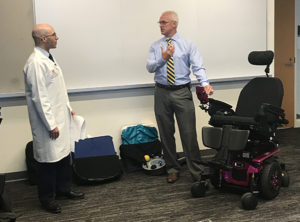By Gabrielle de Coster
“I am the old man in the wheelchair world,” jokes Brian Coltman, ATP/SMS, CRTS, who is the mobility specialist for the University of Michigan Multidisciplinary ALS Clinic.
The “wheelchair world” is the seating and mobility industry, where Coltman said he has catered to patients with complex rehabilitation equipment needs for 38 years. For individuals with amyotrophic lateral sclerosis (ALS), also known as Lou Gehrig’s disease, walkers and wheelchairs can help individuals conserve energy and retain mobility.

Dr. Goutman and Coltman took part in an ALS Association Facebook Live event on September 6, during which they detailed how power wheelchairs can be modified to suit the needs of each individual patient. Watch the replay.
“It makes a tremendous difference in people’s lives: keeping them healthy and extending their quality of life for the greatest period of time I can,” Coltman said.
Coltman said he first entered the field at 16-years-old working part-time at Thomas Surgical Supply. The high school job sparked an interest in the engineering and mechanics of assisted mobility, ultimately pushing him to remain in the industry and eventually yield to “the lure of being the leaders and the best” in joining UM in 2011.
“There are people in the industry who have a personal link,” he said. “Mine is a different story; I just found intrigue.”
Without an ingrained connection to initiate his industry involvement, Coltman said the work became personal through investing in relationships with individuals as people, not just patients.
“There will be certain points throughout their (ALS) diagnosis and the disease process when I’ll be at their homes problem solving different types of issues multiple times a month,” Coltman said. “So you can get to know them, their families, and caregivers.”
“The service that Brian provides to our patients is critical to our multidisciplinary approach,” said Stephen Goutman, M.D., M.S., the clinical director of the ALS Center of Excellence. “As physicians, patients come to us in the clinic where we provide care and guidance for living with ALS. Brian does an amazing job of going to the patients to really see how they live and provide mobility solutions that enable independence.”
Technological innovation has transformed the extent to which Coltman said he can work through those obstacles with patients.
“Back in the 1980’s, complex rehab was not really defined,” he said. “Power wheelchairs were just manual with motors and a few features, but nothing as helpful as now.”
Notably, he said the recent introduction of Bluetooth into mobility products allows patients to operate a computer mouse or operate electric door motors.
“The equipment now is far more user-friendly in the patient’s home environment; it has adjustability that has never been present before,” Coltman said. “I can take one chair and modularly change or adjust things on it for an extended period of time…maximize the performance for the person’s needs.”
While solutions continue to improve with technology, Coltman said the industry’s advancement is restrained by sparse funding sources.
“That (limited funding) is probably the biggest challenge and the most frustrating thing – the limitations that the funding places on the equipment,” said Coltman. “There’s a lot of technology out there inhibited because federal funding limits the access.”
Although understanding product technology and logistics are key facets of the patient experience, Coltman said the emotional component is also significant.
“There’s a psychological challenge to accepting assisted mobility,” said Coltman, who urges his patients to “redefine it in their heads as being a benefit” early on.
While responsible for making patient’s lives easier and better, the patients give Coltman a redefined perspective on life in return, he said.
“I learn to appreciate life,” Coltman said. “Doing this profession, you have a great appreciation for the simple things. It takes a lot to make me have a bad day.”

